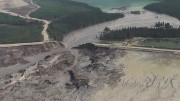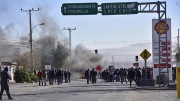“Never, never, never give up.” More often than not in mining, this proves to be great advice.
Such has been the case for Gold Reserve and Kinross in late October, with both companies salvaging some monetary gain from gold mega-projects derailed many years ago by politics in South America.
Gold Reserve is celebrating a big win in the form of a positive judgment by a three-member tribunal of the International Centre for Settlement of Investment Disputes (ICSID), a body of the World Bank. The judgment allows for $740.3 million in compensation for the effective expropriation of its Brisas gold project in 2008 by the Venezuelan government, a move that Gold Reserve had argued violated the Canada-Venezuela Investment Treaty, as well as Venezuela’s own laws.
The company had spent US$300 million half-building the Brisas mine, and another $20 million on legal bills in the ensuing six years of limbo in court.
Gold Reserve had originally asked for $1.8 billion in compensation, but is happy to get quarters rather than cents on the dollar, and has described its ICSID win as a “stunning victory.”
Southeastern Venezuela’s Bolivar State was a popular destination for global miners in the late 1990s, with companies such as Placer Dome, Crystallex International, Gold Reserve, Gold Fields, Bolivar Goldfields and Rusoro descending on the historic Kilometre 88 and El Callao gold districts to run and develop significant mines. However in the early 2000s, the depressed gold price and increasing interference from Hugo Chavez’s anti-capitalist government caused foreign miners to drift away. Those who stuck around and reckoned they could work with Chavez’s government in a way similar to Sherritt International working harmoniously with the Cuban government were eventually punished for the gamble, with projects by Crystallex, Gold Reserve and Rusoro all running aground one after the other.
Obviously, the next question is whether Gold Reserve will ever see any of that money. There is reason for optimism, as the Venezuelan government has always paid its bills in a pragmatic fashion, despite periodic heated anti-capitalist rhetoric from its leadership.
Kinross has similarly endured a long arc of history at its Fruta del Norte high-grade gold deposit in southeastern Ecuador, and has clinched a deal to sell it to Lundin Group’s Fortress Minerals for US$240 million in cash and shares.
Kinross originally picked up the property, which is one of the top mineral discoveries of the new millennium, for $1.2 billion in cash and shares though its acquisition of Aurelian Resources in July 2008. The deal was widely seen at the time as a gamble due to work at the site having been halted by the broadly anti-capitalist Ecuadorian government shocking the mining world in April 2008 by ordering all mineral exploration in the country to cease — an act that put mineral exploration and mine development in the country on ice to the present day.
Fortress — which will change its name to “Lundin Gold” and become the group’s primary gold vehicle — notes that the project has seen US$275 million in investments since its discovery in 2006, and hosts 23.5 million indicated tonnes grading 9.59 grams gold per tonne, or 7.3 million contained oz. gold, plus 14.5 million inferred tonnes at 5.46 grams gold, or 2.6 million contained oz. gold, with “additional significant resource upside potential.”
There have been rumblings over the last few months that the Ecuadorian government is once again getting serious about improving the foreign investment climate for its small but potentially profitable mining industry.
Fortress concurs with this view, and stated that the government there “has been communicating the potential for mining policy reforms in order to improve international investment in the country’s mining sector.”





Be the first to comment on "Editorial: Some satisfaction for Gold Reserve and Kinross"